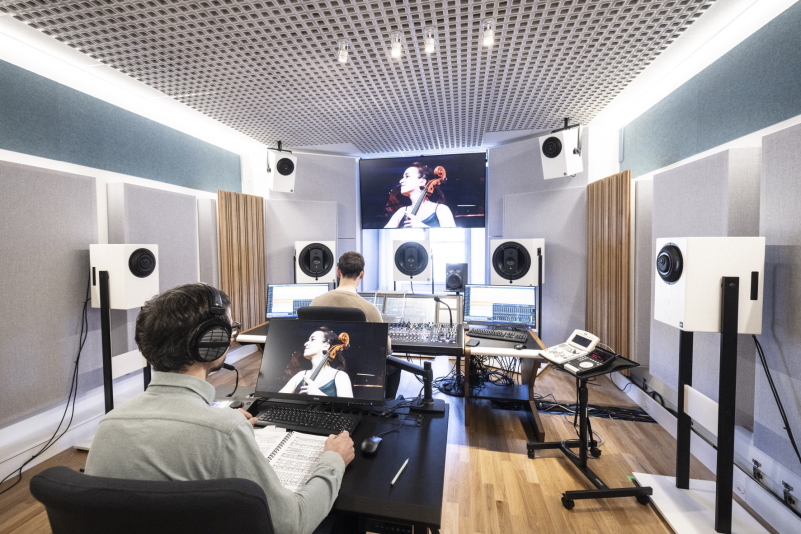Lawo AoIP Infrastructure for Training Sound Engineers

With a history dating back to 1817, the University of Music and Performing Arts Vienna (mdw) is one of the largest music universities in the world. With more than nine locations spread across Vienna, the mdw also provides courses for various instruments, conducting, music education, performing arts, and audio engineering. The university and Lawo collaborated to install a Lawo mc²56 MkIII audio production console with the A__UHD Core in the mdw's “Tonregie 1”, which is now being used to both train students and for daily productions. The new AoIP equipment also includes a Lawo Power Core and an A__stage64 as a stageboxes for campus-wide aggregation of audio signals. The mdw's new infrastructure uses a RAVENNA network, which can integrate formats such as MADI or AES/EBU. DANTE devices within the network are supported via an expansion card in the Lawo Power Core. The installation enables productions of a wide variety of genres, all supported by the integration of a WAVES server.
“Our requirements for high-quality internal productions and sound engineer training easily explain why we chose the Lawo mc²56,” states Pit Kaufmann, mdw project team member and head of implementation. “One focus is on the Tonmeister degree program. During the six-year bachelor's/master's program, graduates should encounter typical market technologies and learn to work with various systems in different scenarios. The open concept of Lawo consoles allows different applications and workflows to be defined, taught, and produced according to coursework requirements. Presets make it easy to simulate different realistic situations – from producing small ensembles, orchestras, drama performances and operas. Thanks to the clearly structured interface and configurations, even inexperienced users can use the console to carry out their first productions quickly and without in-depth explanations.”
Kaufmann points out another advantage: “With the mc²56 console, it is possible to split the mixing console so that two people can work on it independently of each other. For an opera production, we can have one person mixing the orchestra and one person mixing the soloists. In the future, we want to use the Lawo console to expand the production and streaming of multi-channel formats,” says Kaufmann.
The “Tonregie1” studio is one of the university's largest and, along with numerous others located in mdw's new “Future Art Lab”, is available for training in the Tonmeister program. “There's a lot of teaching here with different focuses, both group and individual,” explains Kaufmann. “In the group classes, topics such as studio productions and recording management will be covered, with a sound engineer sitting live at the console to mix the music. In the ‘studio practice’ courses, students can be taught at the Lawo console. This is not just about operation and functionality, but also about technical details and demonstrating different mixing approaches.”
“Tonregie 1” is also used for other areas of the mdw's course offerings, such as for the regular studio productions that are mandatory for master's or diploma programs and that are carried out entirely in-house. Another special feature: in cooperation with other universities, bidirectional remote teaching and joint remote music-making is offered. The very low-latency transmission inherent in RAVENNA, enables instrumentalists to play together at different locations, with a mix being created at the Lawo console. Individual tracks that are transmitted live from other locations are also processed via the console so that music students can play along or be taught live remotely.
“Effects can be integrated via the WAVES server and saved automatically as snapshots - with all settings preserved. Now we can easily reproduce the pop and rock genre as well as jazz with low latency, because we simply have access to all these effects that go beyond the DSP of the Lawo console.” Also the mix and post pro of live music video streams for mdw’s on-demand media library are produced in “Tonregie 1.”
“With this integration, practically everything was done remotely,” says Kaufmann, commenting on the course of the project. “All we had to do was screw in two 19-inch frames, set up the console, and connect it to the network - done! Also the system configuration after installation was done remotely. “If someone needs support in operating the Lawo console or a problem needs to be solved, we can use the network via Lawo HOME to access the studio computer and the Lawo console from anywhere and provide support via the visualization software.”
The mdw's sound crew was recently able to gain its first experience with large productions during an opera performance at Vienna's Schlosstheater, where a video control room was available, but no sound control room. “We set up a Lawo A__stage64 and the signals were transmitted over five kilometers to the mdw campus where the mixer and recording manager sat at our Lawo mc²56. The finished mix was then sent back to the Schlosstheater and combined with the video to be broadcast as a live stream. A production like this is only possible with AoIP. While this production was still carried out in stereo, the plan is to produce binaural or 3D audio in the future, which is particularly exciting for streaming. I'm looking forward to our AoIP future with the Lawo,” concludes Kaufmann.
 How to resolve AdBlock issue?
How to resolve AdBlock issue?